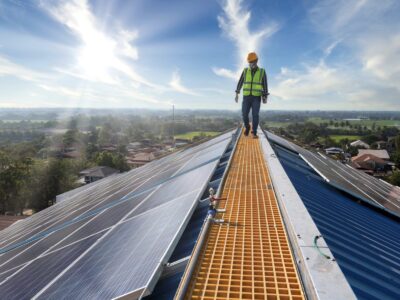(Bloomberg) —
In a way, Alterra Mountain Co. built its business around a rudimentary climate plan. One of the world’s largest operators of ski resorts, the company’s 16 North American locations serve as a hedge against increasingly fickle snowstorms and volatile winters. If Vermont slopes are anemic, for example, Alterra can lean on its resorts in California or Utah. Pass holders, too, can choose a destination based on its current skiing conditions.
Now the company is firming up a more proactive climate strategy, one that includes an energy audit and a pledge to halve its carbon emissions from operations by 2030. In an outline of its climate blueprint released today, Alterra said it also intends to generate or buy enough renewable energy to cover its own electricity use by 2030 and will offset whatever carbon it can’t cut.
“Is it going to make a big difference to the world? Probably not,” says Karen Sanford, Alterra’s chief legal and social responsibility officer. “Could we use our voice to make a bigger difference? Absolutely.”
Few businesses face the existential threat of climate change more directly than the global ski industry. In the US alone, about a third of ski resorts are expected to lose more than half their season by 2050, according to a 2017 study by the US Environmental Protection Agency and the University of Colorado.
For all their sweeping vistas and pristine powder, ski resorts also have a sizable carbon footprint. In addition to the fuel burned getting guests on location, significant electricity and water are needed to make synthetic snow, an increasingly critical way to stretch the margins of the ski season or supplement the slopes after a warm spell. Last year, Alterra’s operations generated 368 metric tons of carbon dioxide equivalent, roughly enough to power 72,000 homes or drive 82,000 cars for a year.
The company plans to trim that tally with a patchwork of solutions, many of them resort-level adjustments such as implementing composting, switching to electric vehicles and installing LED lights and smart thermostats. At its Winter Park Resort in Colorado, for example, Alterra installed a small wind turbine that generates just enough electricity to power a warming hut at the top of the ski lift. At its helicopter ski resort in British Columbia, the company added hydroelectric generators small enough to be placed in mountain streams.
“It’s not a one-size-fits-all approach,” says Darcie Renn, Alterra’s vice president of sustainability.
The company is also hoping that its investments in renewable energy and more efficient snowmaking machines will outweigh any increased demand for fake powder. At Alterra’s Snowshoe Mountain Resort in West Virginia, for example, new snow guns make roughly twice as much snow as the units they replaced, while using about one third as much energy.
Alterra’s impact report is relatively late in coming. Vail Resorts Inc., which owns 41 ski resorts around the world, established its climate plan six years ago, including a pledge to cut or offset its emissions from operations by 2030. As of last year, Vail said it was more than halfway to that goal, in part because the company has bought or built enough renewable energy to cover almost all power use at its North American resorts.
Ski industry climate pledges, however, still don’t account for the carbon footprint of guest travel — known as Scope 3 emissions. Daniel Scott, a climate scientist at the University of Waterloo, says that for a tourism business, such emissions are often more than 100 times greater than those from direct and indirect carbon sources (Scopes 1 and 2). “They’re touting these Scope 1 and 2 targets, but part of their business strategy is the season pass that completely enables a massive Scope 3, which they conveniently don’t look at,” Scott says. “That, to me, is a massive disconnect.”
Alterra’s plan doesn’t ignore Scope 3 emissions entirely; it factors in some employee commuting, for example, and business travel. But it does not measure carbon from the cars and planes dumping skiers on its slopes.
Paradoxically, artificial snow could help forestall some of those travel emissions by making it easier for skiers to stick to their local mountains. “Let’s be honest, nobody is biking from Vermont to Colorado,” Scott says. “And if you’ve got 5,000 skiers coming in on private aircraft, well, you can quickly do the math.”
To contact the author of this story:
Kyle Stock in Skillman at kstock6@bloomberg.net
© 2023 Bloomberg L.P.





